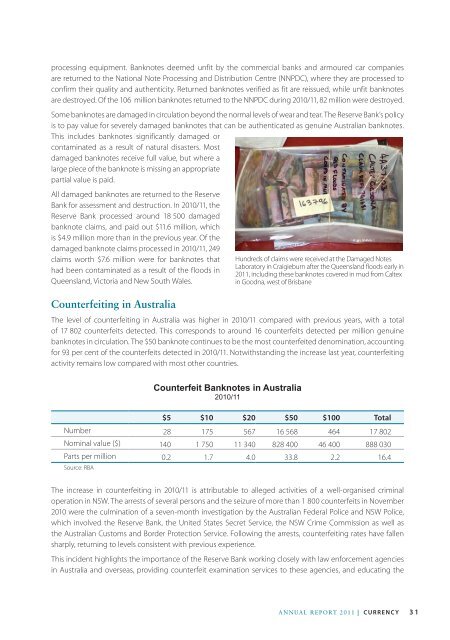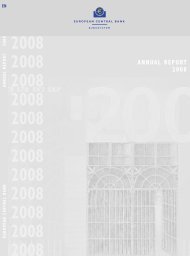Reserve Bank of Australia Annual Report 2011
Reserve Bank of Australia Annual Report 2011
Reserve Bank of Australia Annual Report 2011
Create successful ePaper yourself
Turn your PDF publications into a flip-book with our unique Google optimized e-Paper software.
processing equipment. <strong>Bank</strong>notes deemed unfit by the commercial banks and armoured car companies<br />
are returned to the National Note Processing and Distribution Centre (NNPDC), where they are processed to<br />
confirm their quality and authenticity. Returned banknotes verified as fit are reissued, while unfit banknotes<br />
are destroyed. Of the 106 million banknotes returned to the NNPDC during 2010/11, 82 million were destroyed.<br />
Some banknotes are damaged in circulation beyond the normal levels <strong>of</strong> wear and tear. The <strong>Reserve</strong> <strong>Bank</strong>’s policy<br />
is to pay value for severely damaged banknotes that can be authenticated as genuine <strong>Australia</strong>n banknotes.<br />
This includes banknotes significantly damaged or<br />
contaminated as a result <strong>of</strong> natural disasters. Most<br />
damaged banknotes receive full value, but where a<br />
large piece <strong>of</strong> the banknote is missing an appropriate<br />
partial value is paid.<br />
All damaged banknotes are returned to the <strong>Reserve</strong><br />
<strong>Bank</strong> for assessment and destruction. In 2010/11, the<br />
<strong>Reserve</strong> <strong>Bank</strong> processed around 18 500 damaged<br />
banknote claims, and paid out $11.6 million, which<br />
is $4.9 million more than in the previous year. Of the<br />
damaged banknote claims processed in 2010/11, 249<br />
claims worth $7.6 million were for banknotes that<br />
had been contaminated as a result <strong>of</strong> the floods in<br />
Queensland, Victoria and New South Wales.<br />
Hundreds <strong>of</strong> claims were received at the Damaged Notes<br />
Laboratory in Craigieburn after the Queensland floods early in<br />
<strong>2011</strong>, including these banknotes covered in mud from Caltex<br />
in Goodna, west <strong>of</strong> Brisbane<br />
Counterfeiting in <strong>Australia</strong><br />
The level <strong>of</strong> counterfeiting in <strong>Australia</strong> was higher in 2010/11 compared with previous years, with a total<br />
<strong>of</strong> 17 802 counterfeits detected. This corresponds to around 16 counterfeits detected per million genuine<br />
banknotes in circulation. The $50 banknote continues to be the most counterfeited denomination, accounting<br />
for 93 per cent <strong>of</strong> the counterfeits detected in 2010/11. Notwithstanding the increase last year, counterfeiting<br />
activity remains low compared with most other countries.<br />
Counterfeit <strong>Bank</strong>notes in <strong>Australia</strong><br />
2010/11<br />
$5 $10 $20 $50 $100 Total<br />
Number 28 175 567 16 568 464 17 802<br />
Nominal value ($) 140 1 750 11 340 828 400 46 400 888 030<br />
Parts per million 0.2 1.7 4.0 33.8 2.2 16.4<br />
Source: RBA<br />
The increase in counterfeiting in 2010/11 is attributable to alleged activities <strong>of</strong> a well-organised criminal<br />
operation in NSW. The arrests <strong>of</strong> several persons and the seizure <strong>of</strong> more than 1 800 counterfeits in November<br />
2010 were the culmination <strong>of</strong> a seven-month investigation by the <strong>Australia</strong>n Federal Police and NSW Police,<br />
which involved the <strong>Reserve</strong> <strong>Bank</strong>, the United States Secret Service, the NSW Crime Commission as well as<br />
the <strong>Australia</strong>n Customs and Border Protection Service. Following the arrests, counterfeiting rates have fallen<br />
sharply, returning to levels consistent with previous experience.<br />
This incident highlights the importance <strong>of</strong> the <strong>Reserve</strong> <strong>Bank</strong> working closely with law enforcement agencies<br />
in <strong>Australia</strong> and overseas, providing counterfeit examination services to these agencies, and educating the<br />
ANNUAL REPORT <strong>2011</strong> | Currency<br />
31





![KNOW YOUR NEW GIBRALTAR BANKNOTES - [Home] bThe/b](https://img.yumpu.com/50890985/1/184x260/know-your-new-gibraltar-banknotes-home-bthe-b.jpg?quality=85)
![PAPUA NEW GUINEA - [Home] - Polymer Bank Notes of the World](https://img.yumpu.com/49758743/1/190x143/papua-new-guinea-home-polymer-bank-notes-of-the-world.jpg?quality=85)










